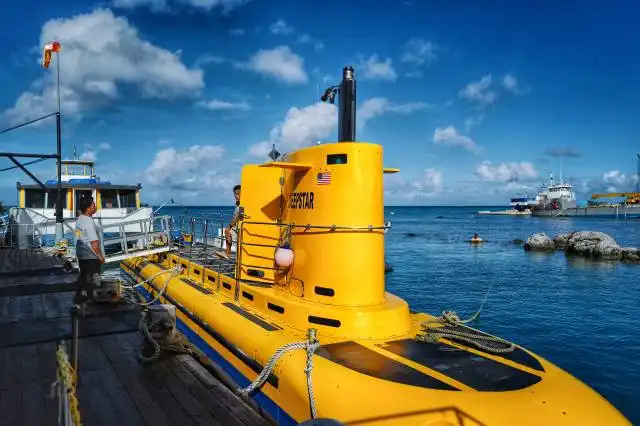Start a Water Taxi Service
Setting Sail on the Seas of Entrepreneurship: Your Water Taxi Service Adventure
| Updated


WATER TAXI SERVICE
Say "Ahoy!" to your new entrepreneurial adventure with a Water Taxi Service! With this business, you'll be steering your way around delightful waterscapes, shuttling tourists and locals alike while they enjoy scenic views and breezy commutes. As a water taxi service, your business will provide on-demand transportation for passengers traveling short distances across water bodies. It's not just about a boat ride, it's delivering a unique aquatic experience right at the heart of your community. Anchors aweigh, sailor!
Jump to Business Plan
RELATED BUSINESS IDEAS
Browse ALL Hospitality & Leisure Ventures Business Ideas
Discover Your Perfect Domain
Unlock the door to your online success with our hand-picked selection of premium domain names. Whether you're starting a new venture or rebranding an existing one, the right domain can set the tone for your digital presence. Browse through our curated list, each with its unique potential to enhance your brand's visibility and credibility.
WATER TAXI MINI BUSINESS PLAN
This a quick reality check to help you identify the strengths and weaknesses of your business concept before you dive in.
Expected Percent Margin:
- Gross Margin: 60-70%
- Net Profit Margin: 15-25%
Earnings Expectations:
- Daily Earnings: $500 - $1,000
- Weekly Earnings: $3,500 - $7,000
- Monthly Earnings: $14,000 - $30,000
- Annual Earnings: $168,000 - $360,000
Actions to Hit Those Numbers:
Licensing and Compliance:
- Initial Investment: Depending on the region, funds needed for obtaining a boat operator's license, business license, and insurance.
Boat Acquisition and Maintenance:
- Boats: Depending on the demand and service quality, 1-3 boats (purchased or leased) might be needed.
- Maintenance: Regular maintenance to ensure safety and operational efficiency.
Marketing and Customer Acquisition:
- Branding: A catchy name and logo are highly recommended.
- Local Alliances: Create partnerships with local hotels, tourism offices, and travel agents.
- Social Media: Regular posts showcasing your services, especially during peak tourism periods.
Route Planning:
- Areas of Interest: Develop routes that cover popular tourist spots and areas of interest.
- Frequency of Service: Schedule to optimize earnings while also considering customer convenience and operating costs.
Staffing:
- Drivers: Employ 1-3 reliable, skilled, and customer-friendly drivers, depending on the number of boats.
- Safety: Regular safety training for the staff.
Cost Control:
- Fuel Costs: Proper route planning and boat maintenance can help in controlling this variable cost.
- Insurance: Shop around to get the best professional liability and property insurance rates.
Business Operations:
- Operating Hours: Align with peak demand periods. More frequent trips during holidays and tourist season.
Remember that all estimates depend on local economic conditions, regulatory environment, and individual business strategies. Always consult a financial advisor for personalized advice.
NOT WHAT YOU HAD IN MIND? Here are more ideas



Browse ALL Hospitality & Leisure Ventures Business Ideas
Grab Your Business Website Name
Before you get caught up in the whirlwind of setting up your business, invest in a domain name. It's a small but significant step that lays the foundation for your brand and makes it easier for customers to find and trust you. Just like you wouldn't build a house without securing the land first, don't build a business without securing your domain name.
"Why? Can't that wait?" Here's why it shouldn't
Step 1: Determine if Starting a Water Taxi Service is the Right Endeavor
Breakdown of Startup Expenses
When starting a water taxi service, it is important to understand the startup costs. These costs include the cost of purchasing a boat, obtaining the necessary licenses and permits, and any other costs associated with getting the business up and running. Additionally, it is important to factor in the cost of insurance, fuel, and any other operational costs. It is also important to consider the cost of hiring employees, as well as any marketing costs.
Breakdown of Ongoing Expenses
Once the business is up and running, there are ongoing expenses that must be taken into account. These include the cost of fuel, insurance, and any other operational costs. Additionally, it is important to factor in the cost of hiring employees, as well as any marketing costs. It is also important to consider the cost of maintenance and repairs, as well as any other costs associated with keeping the business running.
Examples of Ways to Make Money
There are a variety of ways to make money with a water taxi service. These include charging a fee for each ride, offering discounts for multiple rides, and offering special packages for tourists or special events. Additionally, it is possible to offer additional services such as sightseeing tours, fishing trips, or other activities. It is also possible to partner with local businesses to offer discounts or special packages. Finally, it is important to consider other sources of income such as advertising or sponsorships.
Step 2: Name the Business
Naming a business is an important step in the process of starting a water taxi service. It is important to pick a name that is memorable, easy to pronounce, and that reflects the type of business that is being started. A few tips for naming a business include:
Brainstorm: Take some time to brainstorm a few potential names for the business. Think of words that are related to water, transportation, and customer service. Write down any ideas that come to mind.
Research: Once a few potential names have been identified, research them to make sure that the name is not already in use. Check with the local government to make sure that the name is not already trademarked.
Consider the Audience: Think about the target audience for the business and make sure that the name appeals to them.
Keep it Simple: Pick a name that is easy to remember and easy to spell. Avoid names that are too long or complicated.
Consider the Future: Think about how the business may expand in the future and pick a name that will still be relevant.
Once the perfect name has been chosen, the business can be registered with the local government and the process of starting a water taxi service can move forward.
Step 3: Obtain Licenses and Permits
Before starting a water taxi service, it is important to obtain the necessary licenses and permits. Depending on the location of the business, different licenses and permits may be required. For example, in the United States, businesses operating on navigable waters must obtain a Coast Guard license. Additionally, businesses must obtain a business license from the local government. It is important to research the local laws and regulations to ensure that all necessary licenses and permits are obtained.
Insurance
In addition to licenses and permits, it is important to obtain the necessary insurance for the business. This includes liability insurance, which covers any damage or injury caused by the business. It is also important to obtain insurance for the water taxi itself, which covers any damage to the vessel. Additionally, it is important to make sure that all employees are covered by workers’ compensation insurance.
Hiring Employees
Once the necessary licenses and permits have been obtained, it is time to hire employees. Depending on the size of the business, it may be necessary to hire a captain, a deckhand, and a mechanic. It is important to make sure that all employees are properly trained and certified. Additionally, it is important to make sure that all employees are familiar with the local laws and regulations.
Safety
Safety is of the utmost importance when operating a water taxi service. It is important to make sure that all vessels are properly maintained and inspected on a regular basis. Additionally, it is important to make sure that all employees are properly trained in safety procedures. It is also important to make sure that all passengers are aware of the safety procedures.
Step 4: Purchase Equipment
When starting a water taxi service, there are several pieces of equipment that are necessary. These include a boat, a trailer, a motor, life jackets, and other safety equipment. Depending on the size of the boat and the number of passengers, the size of the motor and the type of trailer will vary. It is important to research the different types of equipment available and determine which will be the best fit for the business.
Cost of Equipment
The cost of the equipment for a water taxi service will vary depending on the size of the boat and the type of motor and trailer that are purchased. The cost of a boat can range from a few thousand dollars to tens of thousands of dollars. The cost of the motor and trailer will also vary depending on the size and type of motor and trailer that are chosen. Additionally, the cost of safety equipment, such as life jackets, will need to be taken into consideration.
Financing Options
When starting a water taxi service, it is important to consider financing options. There are a variety of financing options available, such as loans, grants, and crowdfunding. It is important to research the different financing options and determine which will be the best fit for the business. Additionally, it is important to consider the repayment terms of any loans that are taken out.
Maintenance
In addition to the cost of purchasing the equipment, it is important to consider the cost of maintenance. The cost of maintenance will vary depending on the type of equipment that is purchased and the frequency of use. Additionally, it is important to research the different types of maintenance that will be necessary and the cost of those services.
Step 5: Find a Location
Finding the right location for a water taxi service is essential for success. The location should be near a body of water that is large enough to accommodate the size of the boat, and it should be close to a populated area. Additionally, the location should have access to a dock or mooring that can be used to store the boat when it is not in use. It is also important to consider the local regulations for operating a water taxi service in the area.
Securing a Location
Once a suitable location has been identified, the next step is to secure the location. This may involve leasing a dock or mooring from the local government or a private owner. Additionally, the business may need to obtain a permit from the local government to operate a water taxi service in the area. It is important to research the local regulations and obtain the necessary permits before starting the business.
Establishing a Base of Operations
The next step is to establish a base of operations. This may involve renting or purchasing a building near the dock or mooring that can be used as an office and storage space. Additionally, the business may need to purchase or lease a vehicle to transport passengers to and from the dock or mooring. It is important to research the local regulations and obtain the necessary permits before starting the business.
Securing Insurance
The business should also secure insurance to protect against potential liabilities. This may include liability insurance to cover any damages caused by the water taxi service, as well as insurance to cover the cost of repairs and replacements if the boat is damaged or destroyed. Additionally, the business should obtain workers’ compensation insurance to cover any injuries sustained by employees while operating the water taxi service.
Step 6: Create a Business Plan
Creating a business plan is an essential step in starting a water taxi service. A business plan should include an executive summary, a description of the business, a market analysis, an organizational structure, a description of the services offered, a marketing plan, a financial plan, and an appendix.
The executive summary should include an overview of the business, the services offered, the target market, and the financial goals. It should also include a description of the competitive advantages the business has over other water taxi services.
The description of the business should include the business’s name, the type of business, the location, the ownership structure, and the legal structure. It should also include the mission statement and the goals of the business.
The market analysis should include an analysis of the local market for water taxi services, the target market, and the competitive landscape. It should also include an analysis of customer needs and an analysis of the pricing structure of the business.
The organizational structure should include a description of the roles and responsibilities of each employee and the organizational structure of the business. It should also include a description of the management team and the organizational culture.
The description of the services offered should include a description of the services provided, the pricing structure, and the customer service policies. It should also include a description of the safety procedures and the customer service policies.
The marketing plan should include a description of the marketing strategies, the target market, and the budget for marketing activities. It should also include a description of the promotional activities and the customer service policies.
The financial plan should include a description of the startup costs, the ongoing expenses, and the expected revenue. It should also include a description of the financial goals and the strategies for achieving them.
The appendix should include any additional information that is relevant to the business plan, such as resumes of key personnel, financial statements, and customer testimonials. It should also include any additional documents that are necessary for the business plan, such as contracts and legal documents.
Step 7: Market the Business
Once the business is up and running, it is important to market the business to potential customers. Examples of ways to market the business include:
- Creating a website or blog to showcase the services offered and to provide information about the business.
- Utilizing social media platforms such as Facebook, Twitter, and Instagram to reach potential customers.
- Developing a referral program to reward customers who refer new customers to the business.
- Creating promotional materials such as flyers and business cards to distribute to potential customers.
- Developing relationships with local businesses and organizations that may be interested in using the services of the water taxi.
- Advertising in local newspapers and magazines.
- Participating in local events and festivals to promote the business.
Tips for Marketing the Business
In addition to the examples of ways to market the business, there are some tips to keep in mind when marketing the business:
- Make sure the message of the business is clear and concise.
- Focus on the benefits of the services offered rather than the features.
- Make sure the message is consistent across all platforms.
- Utilize visuals to draw attention to the message.
- Focus on building relationships with customers.
- Utilize customer feedback to improve the services offered.
- Monitor the effectiveness of the marketing efforts and make adjustments as needed.
Step 8: Hire Employees
When it comes to hiring employees, it is important to find individuals who are reliable, trustworthy, and have experience in the water taxi industry. You should also look for individuals who have a strong customer service background and are willing to go the extra mile for customers. Additionally, you should make sure to check references and conduct background checks on potential employees.
Training Employees
Once you have hired employees, it is important to provide them with the proper training. This includes teaching them the basics of operating a water taxi, such as safety protocols, customer service, and navigation. Additionally, you should provide them with information on the local laws and regulations that they must adhere to. Furthermore, you should provide them with information on the services that you offer and the pricing structure. Finally, you should provide them with the necessary tools and equipment they need to do their job.
Step 9: Launch the Business
Launching a business can be a daunting task, but with the right preparation and planning, it can be a smooth process. Before launching, it is important to make sure that all legal and regulatory requirements are met. This includes obtaining any necessary licenses and permits, as well as registering the business with the appropriate government agencies. Additionally, it is important to secure any necessary insurance coverage, such as liability insurance. It is also important to create a marketing plan to ensure that potential customers are aware of the business. This could include creating a website, advertising in local publications, and utilizing social media. Finally, it is important to make sure that the business has adequate capital to cover any startup costs and ongoing expenses.
EXPLORE MORE CATEGORIES
Browse ALL Business Idea Categories
TAKE THE NEXT STEPS










